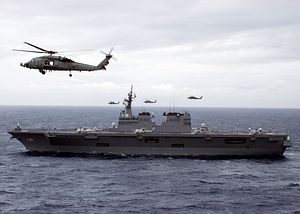A Japanese warship docked at a former U.S. naval base in the Philippines near disputed South China Sea waters Tuesday in another sign of deepening defense relations between the two countries.
The Japan Maritime Self-Defense Force ship Ise, a Hyuga-class helicopter destroyer, docked at the Alava Pier in Subic Bay Freeport Zone at about 9 a.m. local time for a goodwill visit that will last until April 29. The warship carried four helicopters and 360 crew members.
This is the second time in just over three weeks that Japanese vessels have visited Subic, a former U.S. naval base that lies around 125 miles from Scarborough Shoal, which China wrested from the Philippines back in 2012.
“We want to deepen the relationship with the Philippines,” the ship’s captain, Masaki Takada, told reporters while they were being given a tour of the Ise, according to Agence France-Presse. Takada said the visit was also an opportunity for the crew to rest and for the vessel to be replenished.
During its stay, Philippine and Japanese personnel will engage in several defense interactions. Japanese naval personnel will visit the Naval Education and Training Command in San Antonio, Zambales, while Philippine Navy personnel will go on a shipboard tour inside the Japanese vessel.
This is the third time this year that JMSDF vessels have visited the Philippines. Manila received Minesweeper Division 51 on March 2 and the submarine Oyashio along with two destroyers earlier this month. The Oyashio was the first Japanese submarine to visit the Philippines in 15 years (See: “Japan Submarine, Destroyers Visit Philippines”).
As I indicated in a previous piece, port calls are part of a broader Japanese effort to increase its presence in the South China Sea in 2016 (See: “Japan Eyes Bigger South China Sea Presence in 2016”).
This is the Ise’s second visit to the Philippines, with the first coming during international disaster relief efforts in 2013 as part of Operation Sankai following Typhoon Haiyan, the deadliest typhoon ever recorded in Philippine history that killed over 6,300 people.

































